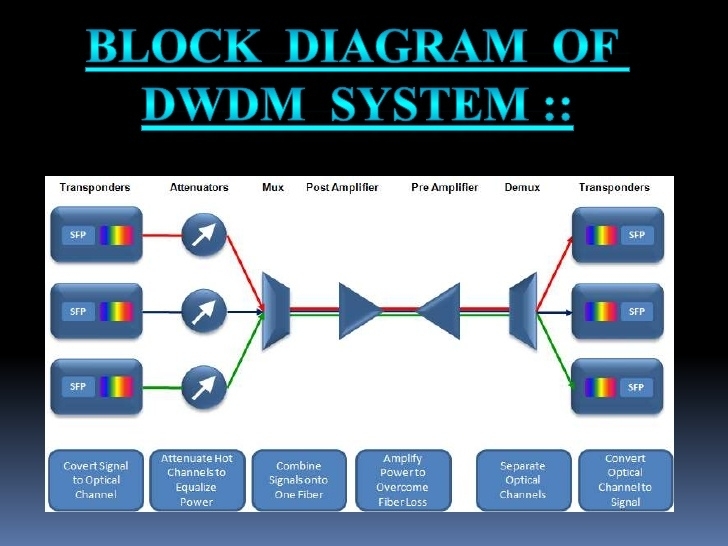- Related articles
- How do they differ? PCI vs PCI-E vs AGP
- Optical Transceivers for Cisco SLM224PT-UK Switch
- Optical Transceivers for Cisco WS-C2960XR-48TS-I Switch
- All Cisco XFP-10GZR-OC192LR’s Information (Overview, Features, Datasheet PDF, Price, Speci
- Applicable to 1000BASE-BX Standard optical transceiver models
- All Cisco CWDM-GBIC-1510's information (List price, Specs, Datasheet PDF, Compatibility ma
- All Cisco AJ906A's information (Specs, Datasheet PDF)
- Optical Transceivers for Cisco IE-2000-8TC-G-N Switch
- All Cisco WS-G5483's information (List price, Specs, Datasheet PDF, Compatibility matrix)
- Optical Transceivers for Cisco SG500-28MPP-K9-G5 Switch

Definition
Dense Wavelength Division Multiplexing (DWDM) is an associate extension of optical networking. DWDM Technology devices mix the output from many optical transmitters for transmission across one fibre. At the receiving end, other DWDM Technology device separates the combined optical signals and passes every channel to an optical receiver. Just one fibre is employed between DWDM Technology devices rather than requiring one fibre per transmitter and receiver combined.
DWDM Technology permits many optical channels to occupy one fiber optic cable. A key advantage to DWDM Technology is that its protocol and bit-rate that it works with as many of the DWDM-based networks will transmit information in science,ATM,SONET,SDH, and LAN. Therefore, DWDM concepts will carry differing kinds of traffic at completely different speeds over the associated optical channel. The dwdm fundamentals are essential to understand the overall scenario of the functions of the system.
Significance of DWDM
Voice transmission, email, video, and the multimedia system information area unit just a few samples of services which might be at the same time transmitted in DWDM Technology systems. DWDM Technology systems have channels at wavelengths spaced with zero.4 nm spacing. DWDM Technology may be a variety of frequency division multiplexing (FDM). An elementary property lightweight states that individual light waves of various wavelengths could co-exist severally at intervals in a medium. Lasers area unit is capable of making pulses of sunshine with an awfully precise wavelength. Every individual wavelength of sunshine will represent a distinct channel of data. By combining lightweight pulses of various wavelengths, several channels may be transmitted across one fiber at the same time. Fiber optic systems use lightweight signals at intervals the infrared band (1mm to four hundred nm wavelength) of the spectrum.
Applications
DWDM optical technology permeates multiservice broadband hybrid fibre homocentric (HFC) networks altogether parts of huge metropolitan architectures. They were deployed as their performance matched the tight necessities of the broadband services delivered in baseband digital and FDM analog /digital format and as they became a cheap various to alternative solutions. the continual progress in DWDM optical parts makes the broadband HFC networks less expensive to deploy and maintain (lower operational cost) and will increase their end-to-end capability. The optical multiplexing technology used to increase bandwidth over existing fiber networks. DWDM works by combining and transmitting multiple signals simultaneously at different wavelengths on the same fiber. The technology that puts data from different sources together on an optical fiber, with each signal carried at the same time on its own separate light wavelength.
What is the difference between SDH & DWDM technology?
DWDM is just a Layer 1 protocol. Different frequencies (colours/wavelengths/lambdas) for different connections over the single fibre. SDH (which is different to SONET btw) is a higher level network structure which runs over fibre (but not necessarily utilising DWDM).Carriers use SDH networks for all their traffic.SDH is designed with heaps of "rings". These rings will have ADM's (Add Drop Multiplexers) at different locations where they need to provide SDH access. The rings inter-lock so that the traffic can get where ever it needs to go.
What is DWDM network?
DWDM network consists of multiple signals which are simultaneously sent at different wavelengths from the same fibre and this multiplies the capacity of the medium. In the access DWDM network accommodate multimedia, broadband, and IP traffic. DWDM that corresponds to the superimposition of optical signals at different wavelengths closely spaced at 100 GHz or less on each fiber, becomes, as a matter of fact, the unavoidable solution, not only for a capacity increase at lower cost, but also for switching and routing in the optical domain.
Conclusion
Dense wavelength division multiplexing (DWDM) is an extension of optical networking. DWDM devices combine the output from several optical transmitters for transmission across a single optical fiber. At the receiving end, another DWDM device separates the combined optical signals and passes each channel to an optical receiver. Only one optical fiber is used between DWDM devices (per transmission direction). Instead of requiring one optical fiber per transmitter and receiver pair, DWDM allows several optical channels to occupy a single fiber optic cable.A key advantage to DWDM is that it's protocol and bit-rate independent. DWDM-based networks can transmit data in IP,ATM,SONET,SDH and Ethernet .Therefore, DWDM-based networks can carry different types of traffic at different speeds over an optical channel.Voice transmission, email, video and multimedia data are just some examples of services which can be simultaneously transmitted in DWDM systems.
Please click to check more related concepts:
| Transceivers Wavelength | Application |
| Bidi | |
| WDM |






































































